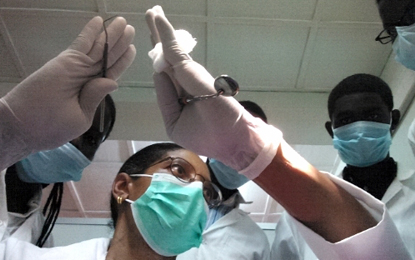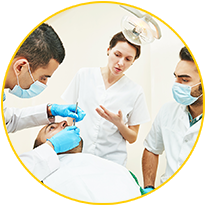The University of Rwanda graduated its first-ever class of dentists on November 2, 2018. With fewer than 40 registered dentists in a nation of more than 12 million, this is a major accomplishment.
Behind the scenes, University of Maryland School of Dentistry (UMSOD) volunteers played a critical role in supporting the development of the school. In particular, Valli Meeks, DDS, MS, RDH, associate professor in the Department of Oncology and Diagnostic Sciences, was instrumental in identifying the need for oral health education in Rwanda and in helping provide support.
Meeks was a founding partner of the Human Resources for Health (HRH) Rwanda Oral Health, US expat team. The HRH program was launched in 2011 by the Clinton Health Access Initiative and in partnership with the Rwandan Ministry of Health.
The goal of the program was to strengthen the Rwandan health education and delivery system and build capacity for care. Although dental care was not part of the plan, Meeks advocated for its inclusion.
“Thanks to the impassioned argument of Dr. Meeks, oral health was incorporated into the HRH plan,” says Jane Barrow, Associate Dean for Global and Community Health at Harvard School of Dental Medicine and member of the HRH-US expat team.
After initial planning, the dental school was established with support from a partnership between HSDM and the University of Maryland Baltimore (UMB). While HSDM took the lead implementing the Bachelor of Dental Surgery program, Meeks worked with her UMSOD colleagues to help enhance the curriculum and continuing education programs, as well as donate equipment and supplies.
“The (UMSOD) faculty were very supportive in helping me review the University of Rwanda’s courses, particularly, radiology, prosthodontics, and restorative dentistry.”
Meeks specifically credits Howard Strassler, DMD, professor and director of the Division of Operative Dentistry, with providing useful information on basic restorative preparation.
“We helped to update their instructional materials, as well as their instructional methods,” says Meeks, “which was critical because the students would often do numerous procedures in one clinic session since they weren’t always sure when the patient would return. Patients travelled from all over, and they may not always come back in six months.”

Valli Mees, DDS, MS, RDH, provides instruction to Rwandan dental students
In addition, Meeks provided hands-on clinical instruction to the students during her time in country, focusing on clinical organization.
“I called it my ‘efficiency clinic,’” she says, “Students would seat their patient first, then spend the next 20-25 minutes getting instruments, supplies and setting up the operatory all while the patient was just sitting there. I would remind them that ‘before you seat your patient, you need to have your operatory set up and instruments in place ready to go,’ especially since most patients had already spent a significant amount of time traveling to get to the dental clinic and waiting to be seen.”
Meeks also collaborated with a variety of sources to get critical supplies, such as dental operatory lightbulbs, blood pressure cuffs from corporate partners, and leftover instruments and supplies from UMSOD graduating seniors. Most critically, she was able to acquire and donate XCP (Extension Cone Paralleling) instruments, which the dental school sorely needed in order for the students to learn how to take high-quality x-rays.
“Whatever resources we had available, we were able to put into Rwanda,” says Meeks. “Whenever we were asked to do something, we pulled through.”
Meeks continues to visit and help coordinate Continuing Education programs. One of her long term goals is to help the HRH determine the scope of work for the new generations of dental therapists and dental surgeons who are graduating.
“The challenge is reconciling the two positions. We have to take it a step further to the governing levels and say ‘we have these two groups of oral health care providers; how are we going to define their roles’,” she says.



